How to
Common Baking Mistakes to Steer Clear of When Working with Chocolate, as Advised by Professional Chefs
Baking with chocolate is a heavenly experience that can be enjoyed by novice and experienced bakers alike. However, working with chocolate requires a bit of finesse and precision, and even the slightest mistake can ruin the end result. To help you achieve baking perfection, we have compiled a list of common mistakes to avoid when baking with chocolate, as advised by professional chefs.
Choosing low-quality chocolate
The quality of the chocolate you use in your baking can make a significant difference in the outcome of your desserts. Professional chefs suggest opting for high-quality chocolate that contains a minimum of 60% cocoa solids. Cheap, low-quality chocolate typically contains more sugar and fewer cocoa solids, which can result in a less rich and less chocolatey flavor.
Improperly melting chocolate
Melting chocolate is a crucial step in baking with chocolate, and it’s essential to do it correctly. One of the most common mistakes is overheating the chocolate, which can cause it to become lumpy or seize. Professional chefs recommend melting chocolate slowly and gently, either using a double boiler or in short increments in the microwave.
Using cold ingredients
When baking with chocolate, it’s essential to use ingredients that are at room temperature, including eggs, butter, and milk. Cold ingredients can cause the melted chocolate to solidify, leading to clumps in the batter or frosting.
Not tempering chocolate
Tempering chocolate is a process of heating and cooling that ensures the chocolate has a shiny appearance and a smooth texture. Tempering chocolate can be a bit intimidating for novice bakers, but professional chefs recommend doing it to achieve the best results. Improperly tempered chocolate can result in a dull finish or white streaks on the surface.
Overmixing batter
When adding melted chocolate to batter, it’s essential not to overmix. Overmixing can cause the batter to become tough and dense, resulting in a less enjoyable texture. Instead, mix until the ingredients are just combined.
Not measuring ingredients accurately
Accurate measurements are critical when baking with chocolate. Even slight variations in measurements can impact the texture and taste of your desserts. Use a kitchen scale or measuring cups and spoons to ensure precise measurements.
Using expired ingredients
Expired ingredients can impact the flavor and texture of your baked goods, including chocolate desserts. Check expiration dates on all ingredients, especially baking powder and baking soda, which can affect the rise of your desserts.
Not allowing enough time to cool
After baking with chocolate, it’s essential to let your desserts cool completely before frosting or decorating them. Rushing this step can cause frosting to melt or become runny, resulting in a less attractive and less appetizing end product.
Overbaking
Overbaking chocolate desserts can result in dry, crumbly treats that lack the rich flavor and smooth texture of perfectly baked treats. Keep a close eye on your desserts and remove them from the oven as soon as they are fully cooked.
Not experimenting
Baking with chocolate is a delightful adventure, and professional chefs recommend experimenting with different recipes, techniques, and ingredients to find what works best for you. Don’t be afraid to try new things and have fun in the kitchen. You might just discover your new favorite chocolate dessert.
